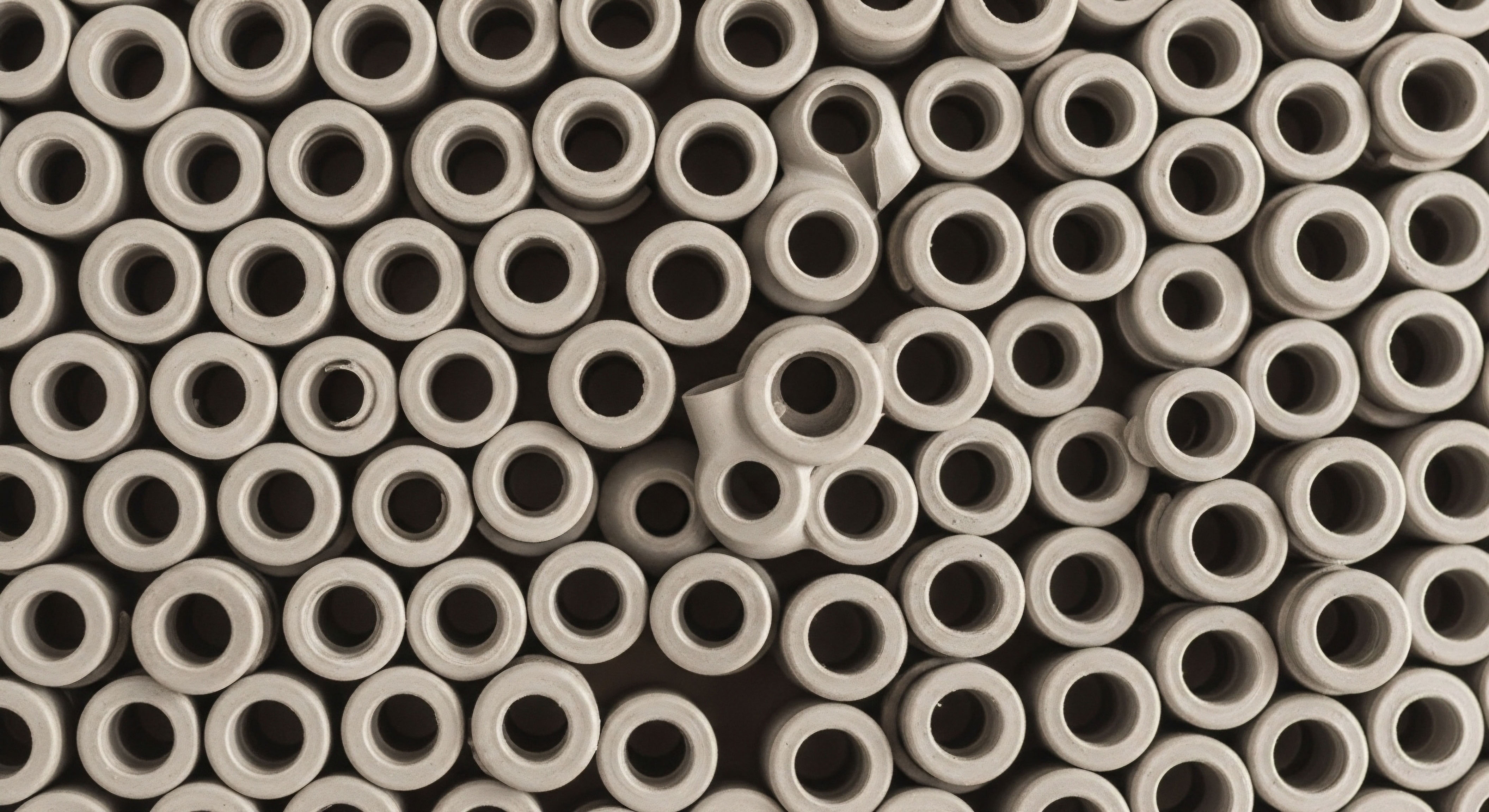

Fundamentals
The question of whether lifestyle choices can entirely substitute for formal Testosterone Replacement Therapy (TRT) touches upon a deep and personal aspect of a man’s health journey. You feel a shift in your body ∞ a subtle decline in energy, a change in mood, a loss of that vital edge ∞ and you seek a path back to your optimal self.
The search for a solution often leads to a crossroads between natural methods and clinical intervention. The answer lies in understanding the profound connection between how you live and how your endocrine system functions. Your body’s hormonal network is a responsive, intricate system, and your daily actions are in constant communication with it.
Viewing the endocrine system as a finely calibrated instrument provides a useful perspective. Hormones like testosterone are messengers in a constant feedback loop with the brain, specifically the hypothalamus and pituitary gland. This communication network, the Hypothalamic-Pituitary-Gonadal (HPG) axis, governs the production of testosterone in the testes.
It is exquisitely sensitive to signals from the rest of the body. Severe stress, poor sleep, nutrient deficiencies, and a sedentary lifestyle all send disruptive signals to this axis, potentially lowering the volume on testosterone production. Conversely, targeted nutrition, strategic exercise, and restorative sleep send powerful signals that encourage robust function.
Lifestyle modifications act as primary inputs that can either support or undermine the delicate balance of the body’s hormonal architecture.
For some individuals, particularly those with testosterone levels in the low-normal range or those whose decline is directly attributable to correctable lifestyle factors, a dedicated and precise recalibration of diet and exercise can produce a significant restoration of hormonal function.
This process involves supplying the body with the raw materials for hormone synthesis and signaling to the HPG axis that the body is safe, healthy, and ready to thrive. It is an active, participatory approach to reclaiming your body’s innate capacity for vitality.

The Architecture of Hormonal Health
Understanding your body’s hormonal control system is the first step toward influencing it. The HPG axis functions as a command-and-control hierarchy. The hypothalamus releases Gonadotropin-Releasing Hormone (GnRH) in pulses. This GnRH signal travels to the pituitary gland, instructing it to release Luteinizing Hormone (LH) and Follicle-Stimulating Hormone (FSH).
LH is the direct messenger that travels through the bloodstream to the Leydig cells in the testes, signaling them to produce testosterone. Testosterone then circulates throughout the body to perform its many functions, and it also signals back to the brain to moderate the release of GnRH, completing the feedback loop.
Lifestyle factors directly impact every stage of this process. For instance, chronic caloric restriction or a diet lacking in essential micronutrients can suppress GnRH pulses from the hypothalamus. Excess body fat, particularly visceral fat, increases the activity of an enzyme called aromatase, which converts testosterone into estrogen.
This conversion not only lowers available testosterone but also sends a stronger inhibitory signal back to the brain, further suppressing the entire axis. These mechanisms illustrate that low testosterone is often a symptom of broader systemic imbalances, which lifestyle changes are uniquely positioned to address.


Intermediate
Moving beyond foundational concepts, a more granular examination reveals precisely how diet and exercise protocols influence testosterone biosynthesis and signaling. The conversation shifts from whether lifestyle matters to how we can strategically implement it to produce a measurable physiological response.
This involves looking at nutrition as a tool for managing inflammation and providing hormonal precursors, and viewing exercise as a potent stimulus for the entire endocrine system. For men considering or currently undergoing TRT, these interventions can amplify the therapy’s benefits and create a more resilient hormonal environment.
A structured exercise program, for example, does more than just burn calories. Resistance training, in particular, creates a significant metabolic demand and stimulates a cascade of hormonal responses. The act of contracting muscles under load signals the body to repair and grow, a process that involves the coordinated release of multiple hormones, including testosterone and growth hormone.
High-Intensity Interval Training (HIIT) has also been shown to be an effective stimulus for testosterone production, likely due to the acute stress response it generates, which can positively modulate the HPG axis when followed by adequate recovery. These are not passive activities; they are direct inputs into the system.

Nutritional Protocols for Hormonal Optimization
Dietary strategy extends far beyond a simple caloric deficit. A protocol designed for hormonal support focuses on nutrient density, blood sugar regulation, and healthy fat intake. Cholesterol, for instance, is the molecular backbone from which all steroid hormones, including testosterone, are synthesized. Diets severely lacking in healthy fats can deprive the body of these essential building blocks.
Furthermore, chronic high blood sugar and insulin resistance, often driven by a diet high in refined carbohydrates, are strongly linked to lower testosterone levels. An inflamed internal environment and high levels of the stress hormone cortisol can also suppress testicular function. Therefore, a nutrient-dense, anti-inflammatory diet is a cornerstone of natural testosterone support.
Key nutritional components include:
- Zinc ∞ This mineral is a critical cofactor in testosterone production, and deficiency is linked to hypogonadism.
- Vitamin D ∞ Functioning as a pro-hormone, Vitamin D receptors are found in the testes, and its levels are positively correlated with testosterone.
- Healthy Fats ∞ Monounsaturated and saturated fats from sources like avocados, olive oil, and quality animal products provide the necessary cholesterol for hormone synthesis.
- Protein ∞ Adequate protein intake supports muscle mass, which is both a result of and a contributor to healthy testosterone levels.

Exercise as an Endocrine Stimulant
When comparing different forms of exercise, it becomes clear that the type of physical stress applied to the body yields different hormonal outcomes. While all movement is beneficial, certain modalities are more effective at signaling the HPG axis.
| Exercise Type | Primary Mechanism of Action | Impact on Testosterone | Impact on Cortisol |
|---|---|---|---|
| Resistance Training | Large muscle group activation, metabolic stress, muscle fiber microtrauma. | Acute post-exercise increase; long-term improvements in baseline levels and androgen receptor sensitivity. | Moderate, transient increase that resolves with recovery. |
| High-Intensity Interval Training (HIIT) | Short, intense anaerobic bursts followed by brief recovery periods, maximizing metabolic rate. | Shown to stimulate significant acute testosterone release. | Can cause a significant spike, requiring careful management of recovery. |
| Steady-State Cardio | Prolonged, moderate-intensity aerobic activity. | Minimal direct impact; can lower testosterone if performed excessively (overtraining). | Can lead to chronically elevated cortisol if duration and intensity are too high. |
Strategic exercise combined with TRT can lead to superior outcomes in muscle mass, energy, and overall well-being compared to TRT alone.
For individuals on a TRT protocol, which may include Testosterone Cypionate and agents like Gonadorelin to maintain testicular function, exercise plays a synergistic role. It improves insulin sensitivity, which allows the body to utilize energy and nutrients more effectively, and enhances androgen receptor density in muscle tissue.
This means the testosterone being administered has more “docking stations” where it can exert its effects. In this context, lifestyle changes are not an alternative to TRT but a critical component for maximizing the protocol’s success.


Academic
A systems-biology approach to male hormonal health requires an appreciation for the intricate crosstalk between the Hypothalamic-Pituitary-Gonadal (HPG) axis and other major regulatory networks, including the Hypothalamic-Pituitary-Adrenal (HPA) axis and metabolic pathways governed by insulin and leptin.
The question of whether lifestyle can supplant TRT becomes a matter of assessing an individual’s specific point of dysfunction within this interconnected system. For some men, the primary lesion may be a resilient, multifactorial suppression of the HPG axis that is unlikely to fully resolve without exogenous support. For others, particularly those with low-normal testosterone, lifestyle interventions may be sufficient because they address the root upstream signaling disruptions.
Research comparing the effects of exercise, TRT, and a combination of both provides illuminating data. A study in middle-to-older aged men with low-normal serum testosterone demonstrated that a structured exercise program was more effective than testosterone treatment alone for improving aerobic capacity and reducing visceral adipose tissue.
This suggests that for certain health outcomes, exercise provides benefits that testosterone administration cannot replicate. The addition of testosterone to the exercise group conferred limited additional benefit for these specific markers, although it did have a similar impact on lean mass. This finding positions exercise as a primary therapeutic intervention, with TRT as a potential adjunct to address specific endpoints like lean mass preservation, particularly in the context of caloric restriction for weight loss.

Can Exercise Preserve Gains after TRT Cessation?
One of the most compelling areas of research involves the durability of therapeutic response after TRT is discontinued. A pilot randomized controlled trial investigated this very question. Two groups of men with late-onset hypogonadism (LOH) received TRT for 12 weeks, but one group also participated in a supervised exercise program that continued for the full 20-week study period. After 12 weeks, both groups showed improvements in testosterone levels and symptom scores, with the exercise group demonstrating statistically superior results.
The most significant finding occurred at week 20, after 8 weeks without TRT. In both groups, testosterone levels declined and symptoms worsened compared to their 12-week peak. The group that continued the exercise program maintained significantly higher testosterone levels and better symptom scores than the TRT-only group. This suggests that while TRT effectively elevates hormone levels, exercise may improve the underlying resilience of the endocrine system, making it better able to sustain function after the exogenous support is removed.
Exercise appears to enhance the durability of response to TRT, potentially by improving the baseline function of the HPG axis and reducing systemic inflammation.

Quantitative Outcomes of Combined Intervention
The data from clinical trials allows for a direct comparison of outcomes, highlighting the measurable impact of adding a structured exercise regimen to a hormonal therapy protocol. The improvements are not merely subjective but are reflected in key serological and symptomatic markers.
| Metric | Group I (TRT Only) | Group II (TRT + Exercise) | Statistical Significance |
|---|---|---|---|
| Change in Serum Testosterone (Baseline to 12 weeks) | Significant Increase | Significantly Greater Increase | p < 0.05 |
| Change in Serum Testosterone (12 weeks to 20 weeks – TRT ceased) | Significant Decrease | Lesser Decrease | p < 0.001 |
| Aging Males’ Symptoms (AMS) Score (at 12 weeks) | Improved | Significantly Better Improvement | p < 0.001 |
| AMS Score (at 20 weeks – TRT ceased) | Worsened from 12 weeks | Maintained Better Score | p < 0.001 |
These findings provide a strong rationale for integrating a supervised, progressive exercise program as a non-negotiable component of any hormonal optimization strategy. The data supports the view that exercise does more than just complement TRT; it fundamentally improves the physiological environment in which the therapy operates and may contribute to a more lasting restoration of the system’s own functional capacity.

References
- Low T Clinic. “Harness the Power of Lifestyle Changes to Complement Testosterone Replacement Therapy.” Low T Clinic, 31 Aug. 2023.
- Kim, Myung Ki, et al. “Exercise improves the effects of testosterone replacement therapy and the durability of response after cessation of treatment ∞ a pilot randomized controlled trial.” Investigative and Clinical Urology, vol. 57, no. 4, 2016, pp. 265-72.
- Villareal, Dennis T. et al. “Testosterone Replacement Therapy Added to Intensive Lifestyle Intervention in Older Men With Obesity and Hypogonadism.” The Journal of Clinical Endocrinology & Metabolism, vol. 105, no. 11, 2020, pp. dgaa548.
- Yeap, Bu B. et al. “Testosterone and exercise ∞ effects on fitness, body composition, and strength in middle-to-older aged men with low-normal serum testosterone levels.” American Journal of Physiology-Endocrinology and Metabolism, vol. 318, no. 3, 2020, pp. E371-E381.
- Kim, Myung Ki, et al. “Exercise improves the effects of testosterone replacement therapy and the durability of response after cessation of treatment ∞ A pilot randomized controlled trial.” ResearchGate, uploaded by Myung Ki Kim, July 2016.

Reflection
You have now seen the evidence, the mechanisms, and the data. The information presented here is designed to be a map, showing the intricate pathways that connect your daily choices to your deepest biological functions. This knowledge is the foundation. It transforms the abstract feeling of being “off” into a series of understandable, addressable systems. The path forward begins with a single, powerful question you can now ask yourself ∞ “What signals am I sending my body today?”
Your unique physiology, history, and goals will determine the precise combination of tools required to build the health you envision. For some, a rigorous and dedicated application of these lifestyle principles will be the key that unlocks a renewed sense of vitality.
For others, these same principles will become the essential framework that allows a clinical protocol like TRT to deliver its most profound and lasting benefits. The journey is a personal one, and it starts with the understanding that you are an active participant in the dynamic conversation that is your own health.



